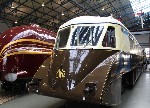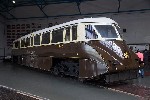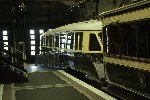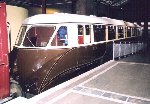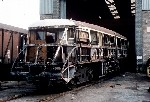4 Great Western Railway Railcar
Home Railway |
Location History |
Swindon Works 63-Feb 65 |
|
Current Location |
|
Hellifield MPD Feb 65-Feb 67 |
|
Current Status |
Static Display |
|
Swindon Running Shed Feb 67-70 |
Current Livery |
GWR Chocolate & Cream |
|
Didcot Railway Centre 70-79 |
TRA Designation |
National Railway Museum 79-Present |
||
Owner |
National Railway Museum |
|
|
Website |
Visited Railways |
RESCO Woolwich (Contract Restoration) Jan 81-Jun 84 |
|
Record Last Updated |
13 January 2024 |
Swindon Steam Museum Jun 84-15 |
|
Preservation Modifications |
|||
Preservation Information 4 is a remarkable early survivor of the GWR railcar fleet. It is the only one to survive with the earlier design of streamlined bodywork and, remarkably for a single unit, it has a buffet counter fitted! Due to ownership uncertainties not fully resolved until 1975, we do not have an exact date that GWR No4 officially entered preservation. However the story begins in 1963 when British United Traction supplied No4 and another classmate to the apprentice training school at Swindon Works. However alterations in training led to the two vehicles being disposed of after just a few months. It was suggested that one of these two cars, which were then residing in a stock shed in Swindon, should be retained for display at the Great Western Railway museum at Swindon. In the meantime 4 was moved in early 1965 for storage at a converted ex Motive Power Depot in Hellifield, which had been prepared as a space for the British Railways Relics Department to store their preserved vehicles. Whilst en-route, 4 sustained damage to the drawbar gear and had to be stopped at Bamfurlong Sidings. Once it had completed its journey, inspection undertaken at Hellifield revealed that the cowling and Klaxon horns at the brake end had been severely damaged and it was concluded that the buffers of the hauling engine must have ridden over 4's during transit. In 1966 custodianship of 4 was passed to the Swindon Corporation, who moved it to Swindon Running Shed the following year. By 1970, 4 had been sub-leased to the Great Western Preservation Ltd, a volunteer-based restoration company, and moved to the Didcot Railway Centre for them to repair the damaged end and completely overhaul the engines. In 1975 the National Railway Museum opened, and their new Advisory Committee set up a working party to ascertain the legal ownership of all 77 of the locomotives which were then considered to have been part of the National Collection. 4 remained one of three items for which the party could not ascertain the ownership within the timeframe they had been given. This is likely due to early confusion over the status of the leasing to the Swindon Corporation who initially appeared to believe 4 to have been gifted. Notably the Great Western Preservation Ltd records noted that the vehicle owners were the Swindon Corporation, and in their 1975 Annual Stock Report they described 4's owners still as Thamesdown Borough (the former Swindon Corporation). The question of ownership was resolved shortly after with the railcar noted as a part of the British Transport Commission Collection, and as such ownership was formally passed with the rest of the locomotives to the newly formed National Railway Museum in 1975. After a National Railway Museum site visit in 1978, the question of 4's condition and care was raised, with particular concerns that the vehicle appeared to be suffering neglect at Didcot, stored outside without proper protection, open windows, and leaks in the roof. They concluded the vehicle was receiving less attention than those which were owned by the GWPL and its counterparts, and consequently the matter of removing the vehicle as a matter of urgency to the National Railway Museum in York was raised. In a further update in 1978 from the GWPL regarding the status of work on 4, they noted that the railcar had received attention to its engines which were nearing completion, as well as the general bodywork. It was also noted in their report however that due to the dangerous condition of the wiring insulation the vehicle could no longer be considered a working item without receiving extensive re-wiring and new batteries. The GWPL suggested that they would no longer be able to put resources into the project due to other commitments and also believed the railcar should be removed to York. In early 1979 the vehicle was transferred dead on its own wheels as special freight from Didcot to York with a brakevan at each end. In July of that year the NRM approached RESCO Railway (Woolwich) regarding carrying out further works to the vehicle with an eye to returning it to active running. However, in March of 1980 the survey results from RESCO had found that whilst the vehicle body was in good condition, the structural framework and cladding, as well as the mechanical equipment needed considerable work. Their assessment deemed the apparent good condition as little more than an effective paintjob. In April 1980 the decision was taken to contract RESCO to repair the vehicle body, both interior and exterior. Between the 6th and 7th of January 1981 the vehicle was transported by BR to Ripple Road Depot by rail, before being collected by RESCO and transported the remainder of the way by road. It was noted by RESCO however that the vehicle had sustained further limited damage to the area of the drawhook fastening when the shank of the draw eye fastening broke while being shunted by BR. RESCO assessed two options for the restoration of this vehicle, the first being for sufficient work to enable the railcar to be towed without further damage to mechanical equipment and bring it up to an acceptable condition for BR. The second option was for a complete overhaul to allow for the vehicle to run under its own power again. Owing largely to cost, the first of these two options was chosen by February of 1982. By February of 1984 the works to No. 4 were complete. Owing to the vehicle being in a poorer state than RESCO had originally been able to judge, the costs of restoration had been considerably over-run. Agreement was reached by the National Railway Museum for the railcar to be displayed at the Great Western Railway Museum in Swindon as had originally been envisaged. Transportation of the vehicle from the RESCO works in Erith to Swindon Museum took place around June of 1984. The vehicle remained at the GWR Museum in Swindon on extended loan until 2015, when the vehicle was moved back to York. 4 is currently on full public display, undercover at the National Railway Museum in York. |
|||
Future Plans |
|||


